| |
|
|
|
|
English Family Quick Links
|
|
|
|

|
|
|
|
|
Family 12: Royal Mare (Sedbury Royal Mare)
 |
VIEW DESCENT CHART
As noted in other sections of Heritage, the appellation "royal mare" was a name used to describe a number of mares in the Sedbury stud of the D'Arcy family (both father and son, named James), and occasionally of mares derived from the Royal Stud at Tutbury (dispersed by Cromwell) or later, at Hampton Court. Most historians agree that the use of the term "royal" for at least some of these mares derives from the 1661 agreement between James D'Arcy (the elder), the king's Master of the Horse, and Charles II, for D'Arcy to provide colts to the king from mares of his (D'Arcy's) "own breed." The "names" of mares during this period were often passed from generation to generation, without change, except, perhaps for adding the prefix "Old" to the dam of a mare by the same name, or "Young" for a daughter. Thus, the term "royal" in a mare's name during the latter half of the seventeenth century, generally indicated a mare was probably a tail-female descendent of a mare from the pre-Cromwellian studs, or a mare of unknown tail-female descent--but of the "D'Arcy breed" used to produce foals as part of the agreement between Charles II and James D'Arcy the elder.
The Family 12 royal mare was probably in the D'Arcy stud at Sedbury, and may have been the same mare who produced the foundation mares of families 8, 16, 25 and 28., and thus might have her own roots in the Layton Barb mare of Family 4. Cedric Borgnis ["Foundation Mares," The British Racehorse, September 1973] presents a case for the common descent of these mares, as well as the foundation mares of families 10, 18,19, 16 and 31, based on circumstantial evidence of a series of unnamed mares by identical sires, as provided in the General Stud Book. In the case of this family, Borgnis proposes that the royal mare in question was, in fact, a mare by (Place's) White Turk, daughter of a mare by Dodsworth, and dam of a mare by Brimmer, a stallion bred by and in service in the D'Arcy stud.
It is not clear why Borgnis equates this particular "royal mare" with the mare by the (Place's) White Turk. According to the Borgnis scheme, the proposed line was:
Layton Barb Mare
|
Mare by Dodsworth
|
Mare by (Place's) White Turk (the Royal Mare of Family 12, per Borgnis)
|
Mare by Brimmer (in D'Arcy stud, by D'Arcy Yellow Turk)
|
Mare by Hautboy (by D'Arcy White Turk)
|
D'Arcy Mare by Old Montagu (a.k.a. Montagu Mare)
Place's White Turk's date of importation is supposed to be 1657, making him a possible, but unlikely candidate, of the Family 12 Royal Mare. The Family 12 Royal Mare, regardless of her sire, probably dates to around 1680 or a little later; both Brimmer and Hautboy were covering mares around the mid 1690s, Brimmer's covers appearing usually a generation earlier than Hautboy's, possibly as early as 1690.
The Montagu Mare was, according to the GSB, "bred by Lord D'Arcy [James D'Arcy the younger], got by his (Old) Montagu." It is from her that the family continues, primarily through Mother Western (grandam of Eclipse) and through a filly by Whiteshirt.
The stallion, (Old) Montagu, identified as belonging to James D'Arcy is somewhat of a cipher, since this is the only mention of him in the GSB, but it is likely he came from, or was descended from horses owned by Sidney Wortley Montagu, a wealthy m.p. who had married the illegitimate daughter of Sir Francis Wortley of Wortley Hall, Leeds. Another mare listed in the GSB, "Old Montague," also in the D'Arcy stud, who was by D'Arcy's stallion, Woodcock, and out of "a mare of the celebrated breed of Lord Montague of Cowdray, Sussex" is unrelated to this mare--the Viscount Montagues of Cowdray were the Browne family, staunch royalists during the Civil War, and Francis, the 2nd Viscount was an enthusiastic racing man during the reign of Charles II. This latter mare was the dam of Sedbury, a good racehorse of the late 1730s, and is the taproot mare of Family 68. |
Royal Mare's
Known Produce:
Mare by Brimmer. Dam of
f. Mare by Hautboy. Dam of
f. Montagu Mare by Darcy's Old Montagu. Dam of
f. by Woodcock
Vavasour's Champion c. 1739 by Bolton Goliah
f. Mother Western by Smith's Son of Snake. Dam of
Spiletta f. 1749 by Regulus
f. by Whiteshirt. Dam of
f. by D'Arcy Chestnut Arabian
f. by Smith's Son of Snake
f. by Champion |
|
|
FAMILY #12 NOTABLE DESCENDANTS
|
|
|
Family #12 Derby Winners
|
|
|
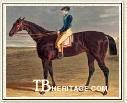 |
| Cadland |
|
|
1828
CADLAND br.c. 1825
(Andrew - Sorcery) |
1972
ROBERTO b.c. 1969
(Hail To Reason
- Bramalea) |
|
|
Family #12 St. Leger Winners
|
|
|
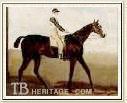 |
| Filho
da Puta | |
|
1791
YOUNG TRAVELLER ch.c. 1788
(King Fergus -
Young Trunnion mare) |
1815
FILHO DA PUTA br.c. 1812
(Haphazard - Mrs.
Barnet) |
1977
DUMFERMLINE b.f. 1975
(Royal Palace -
Strathcona) |
|
|
Family #12 Other Family Members
|
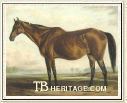 |
| Alice Carneal |
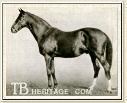 |
| Amphion |
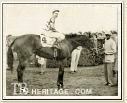 |
| Bed O' Roses |
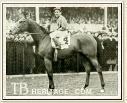 |
| Challendon |
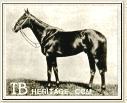 |
| Chanteur II |
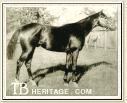 |
| Commando |
 |
| Eclipse |
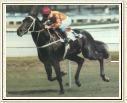 |
| Kingston Town |
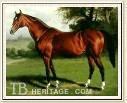 |
| Lexington |
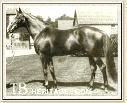 |
| Marcovil |
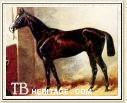 |
| Sensation |
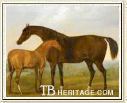 |
| Spiletta |
 |
| Springfield |
 |
| Sterling |
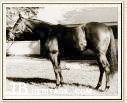 |
| Swoon's
Son |
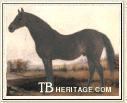 |
| Vandal |
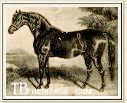 |
| Weatherbit |
|
Alice Carneal b. f. 1836
(Sarpedon - Rowena)
Won once at age five in four starts, the Jockey Club Purse at Georgetown, Kentucky; at age six, lost a tough, fast race to Miss Foote, and was second to Sally Shannon at Louisville, giving away 32 lbs; at age seven was unplaced at Lexington. Dam of the famous Lexington (see below). She also produced the good stakes winner Umpire (1857, by Lecomte), later sent to run successfully in England where he stayed as a stallion (1935 Oaks winner Quashed was one of his descendants). Her daughter Rescue (1854, by Berthune) produced the four-miler Abd-el-Kader (1865, by Australian), later sire of Belmont Stakes winner Algerine and grandsire of Rhoda B., the dam of Epsom Derby winner Orby. Kentucky Derby winner Baden-Baden (1874 by Australian) was the son of her winning daughter Lavender (1855, by Wagner). The excellent Australian race mare Lady Wallace (1902, by Wallace), winner of the AJC St. Leger, the Caulfield Guineas, and the VRC Oaks, Derby and St. Leger, descended from a third daughter out of Alice, Brighton Stakes winner Annette (1859, by Scythian). |
Amphion ch.c.
1886
(Rosebery - Suicide)
"Old Sheep," so-called because he evinced little interest in his surroundings until he was on the track. Won 2 races of 5 at 2; at 3 won the Great Jubilee Stakes, the Doveridge Handicap and the Fern Hill Stakes, running against mediocre competition. At 4 he beat the year's Derby winner and good horse Sainfoin in the Hardwick Stakes, and top horses, including St. Serf, Memoir and Martagon in the Lancashire Plate. At 5 he won the March Stakes and the Stockbridge Cup, in the latter carrying a "crushing" 147 pounds. Sired brother and sister, Sundridge (top sire) and Amphora (dam of Flaming Vixen); Harpsichord, Sonantina, Altesse, Dieudonne, Lally, and Fiona. |
Ballade b.f.
1972
(Herbager - Miss
Swapsco)
A modest
winner of only $12,670, she had a stellar career in the breeding shed. 1992 Canadian Broodmare of the Year, she produced four major stakes winners-- Devils Bag, Saint Ballado, Thaidah and Canadian Horse of the Year, Glorious Song. The latter produced Champion Turf male, Singspiel as well as leading sire and stakes winner Rahy and the good sire and stakes winner Rakeen. |
Bed o' Roses b.f.
1947
(Rosemont - Good Thing)
Champion 2 year old filly in the U.S., winning 9 races from California to New York, including the Selima, the Matron, the Marguerite and Demoiselle Stakes. At 3 she beat the colts in the Lawrence Realization Stakes, and at 4 was once again champion, after winning the Vineland and Comely Handicaps. At age 5 she ran 46 times, winning 18 races, including the Santa Margarita Handicap. She died without producing a foal. |
Challedon b.c.
1936
(Challenger II
- Laura Gal)
Game colt was the first back-to-back
winner of U.S. Horse of the Year title, and a track and world record-setter.
He was the first 3 year old winner of the Hawthorne Gold Cup (1939), one of his 20 wins in 44 starts from ages 2 to 6. Sired 13 stakes winners; offspring included Ancestor, Flitabout, and Signal. |
Chanteur II
br.c. 1942
(Chateau Bouscaut
- La Diva)
Impressive colt ran from ages 3 to 5, winning most of his races in France, his best year his last, winning 6 of his 7 races, including the Grand Prix du Tremplay and the Prix des Sablons. Leading Sire in England in 1953, he got Mamounia, Pinza, St. Leger winning filly Cantelo, Danish classic winner Chantelcair. |
Commando b.c.
1898
(Domino - Emma
C.)
Coarse, muscular, intelligent and kind, he was an impressive 2 year old runner whose only loss that year was due to jockey error. At 3 he won the Belmont Stakes and Carlton Stakes, and then broke down in the Lawrence Realization, although he still placed second. Sired only 27 foals, dying from tetanus after picking up a stone in his hoof while being exercised during his fourth season at stud. His influence on American thoroughbreds is large: sired racehorses and sires Peter Pan, Superman, Celt, Colin, Peter Quince, Transvaal, Ultimus (sire of Himyar) and the good mare Mosquito. |
Conductor ch.c.
1767
(Matchem - Snap
Mare)
He won ten races,
including a King's Plate run in one heat. Matchem's most important son and the one who carried the Godolphin Arabian sire line forward, he got Imperator (sire of Pipator), and the three time leading sire, Trumpator. Trumpator got another leading sire, Sorceror; the great mare Penelope (dam of Waxy, Whalebone, Wire, Web, Whisker, and other early cornerstones of the breed), and Trumpetta, imported into the U.S. and important in early bloodstock there. |
Cox's Ridge
dkb.c. 1974
(Best Turn - Our
Martha)
Tall (16.2 hands) winner of 16 races
in 28 starts to age 5, including the Metropolitan and Oak Lawn Handicaps and the Tom Fool Stakes. Sired 50 stakes winners, including Champions Life's Magic, Cardmania and Vanlandingham. |
Eclipse ch.
c. 1764
(Marske - Spilletta)
Undisputed principal influence on today's thoroughbred bloodlines, he has his own page here at Heritage. |
Hold You Peace
ch.c. 1969
(Speak John - Blue
Moon)
A precocious 2 year old who won the Arlington-Washington Futurity; at 3 he won the Florida Derby. As a sire, he has been a dependable source of precocious individuals, including
stakes winner and leading sire, Meadowlake. |
Kingston Town bl. g. 1976
(Bletchingly - Ada Hunter)
Known lovingly as "The King," he was the first horse in the Southern Hemisphere to win over a million dollars, finishing with A$1,605,790. Overcame suspensory problems to win 30 of his 41 race starts, fourteen of which were at Grade One level, including the premier weight-for-age stakes, the W.S. Cox Plate, three times in succession; in his last attempt, just before the final turn the race caller announced "Kingston Town can't win," but win he did, easily. He was by a champion Australian sire and out of a German mare, bought cheaply in Italy [Thanks to Malcolm Campbell for this description].
|
Lexington b.c.
1850
(Boston - Alice Carneal)
Called the great
horse ever foaled on American soil, Lexington began his race career by
the name of Darley. After purchase by Richard Ten Broeck, who named
him Lexington, he became a superior racehorse and incomparable sire, leading
the North American sire list 15 times. Lexington has his own page here at Heritage. |
Marcovil ch.c.
1903
(Marco - Lady Vilikins)
Despite tendon problems, won 4 of his 8 races between ages 3 and 5, including the Cambridgeshire Stakes. Sired Hurry On, a source of stamina, Miss Matty (dam of Derby winner Papyrus), and My Prince (sire of 4 winners of Aintree's Grand National). Seen in the pedigrees of sporthorses, particularly through Hurry On. |
Sensation br.c.1877
(Leamington - Susan
Beane)
Unbeaten winner
of 8 juvenile starts, including the July Stakes and the Flash Stakes, "without another horse ever extending him....unfortunately he picked up a stone and was lamed and did not race again." Sired Carrie C. and Medje. He was brother to good runner and sire, Onandoga. |
Shinzan b.c. 1961
(Hindostan - Hayanobori)
Smart horse who did not exert himself for minor stakes or allowance races, he was all business when it came to the big races, winning the Japanese Triple Crown. He was one of four Japan Derby winners descending in tail female from Koiwai Bokujo's English import, Beautiful Dreamer (1903, by Enthusiast). He was a successful sire in Japan. |
Spiletta b. f. 1749
(Regulus - Mother Western)
Bred by Sir Robert Eden, she had five foals, includingEclipse and his brother, Garrick (1772), a good runner for the Earl of Abingdon that later got some winners from the mare Sportsmistress (Family 38). Sportsmistress ran once, unplaced, in 1754 and retired to the Duke of Cumberland's stud. Her daughter Properine (1766 by Marske) bred on, was third dam of Oaks winner Scotia; Oaks winners Brown Duchess, Miss Letty and Poison, plus numerous other good runners descend from Prosperine in tail-female. |
Springfield
b.c.1873
(St. Albans - Viridis)
Fractured his pelvis as a yearling, then went on to have a brilliant career on the turf, winning 17 of his 19 races, including the Prince of Wales Stakes, the Gimcrack Stakes, the Fernhill Stakes, Stockbridge Cup, July Cup (twice). Although most of his races were sprints, he also won the Champion Stakes (a little over 1 1/4 miles) carrying 130 pounds with stiff competition, and a 10 furlong race at Newmarket. Sired Derby winner Sainfoin (sire of Rock Sand); Watercress; 1,000 Guineas winner Briar Root; stakes winner Pastorella (dam of Colin); Sierra (dam of Sundridge); Neapolis, the 6-time Leading
Sire in Argentina. |
Sterling b.c.
1868
(Oxford - Whisper)
A game, determined horse, he won the Liverpool Cup and other middle-distance races. He was among the top 20 sires four times, his best youngster the great race colt Isonomy (sire of Gallinule and Seabreeze). Other offspring included three 2,000 Guineas winners -- Enterprise , Enthusiast, and Paradox -- Derby winner Harvester, Atheling, Inchbonny and Foil. |
Swoon's Son b.c. 1953
(The Doge - Swoon)
Sound and solid, winner under all conditions, he was U.S. Champion Handicap Horse of 1957 and Champion Sprinter in both 1957 and 1958 . Won 30 of his 50 plus races (10 times second) in 4 seasons of racing, major wins included Arlington Futurity, American Derby, Equipoise Mile (twice), Wright Memorial Stakes (twice), Balmoral Turf Handicap. At stud, he got Chris Evert (leading filly of 1974), Swoon's Song (stakes winner and dam of Swingtime, among other stakes winners), and 20 other stakes winners from 330 foals. |
Vandal
b.c. 1850
(Glencoe - mare by Tranby)
During a short
turf career, he won at three mile heats, then went to stud in Tennessee. Of stout lineage, he sired the good race mare and producer, Vandalite; Herzog, the best horse of his generation; the first winner of the Preakness Stakes, Survivor, and Virgil, a leading U.S. sire of 3 Kentucky Derby winners.
|
Voltaire bl.c.1826
(Blacklock - Phantom
Mare)
Winner of the Doncaster Cup, and a sire with some impact on the breed, carrying the Bartlett's Childers line of the Darley Arabian forward (tail-male ancestor of Galopin, and thus, St. Simon), through his son, classic winner Voltigeur. He also sired St. Leger winner Charles
the XII , and daughters Volley (dam of The Slave), Sacrifice (dam of Alcestis and Sappho), Lollypop (dam of Sweetmeat), and other good mares. |
Weatherbit b.c.1842
(Sheet Anchor -
Miss Letty)
Inbred to family
12, as his sire, Sheet Anchor was also of this tribe, Weatherbit was a moderate raehorse who won at Ascot and beat some good horses at Goodwood. He left the
Derby winner Beadsman and Doncaster Cup winner Mandrake, and the good maresBrownbread (dam of Manna), Leda (dam of Lady Yardley), Weatherwise (dam of Aneroid), and Weatherwitch, who was sent to the U.S. and became dam of Kentucky Derby winner King Fonso. |
|
|
|
|
|
|
|

